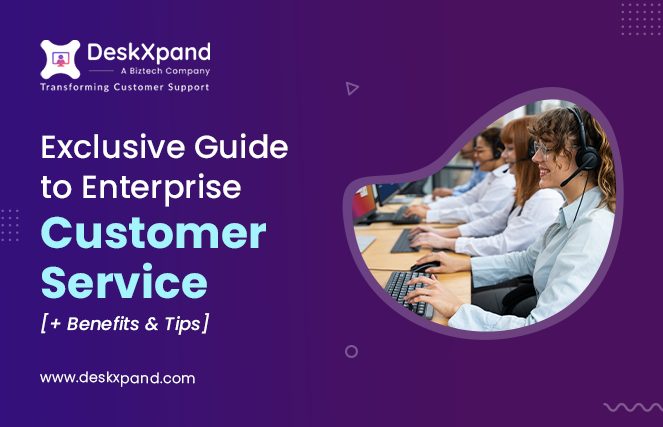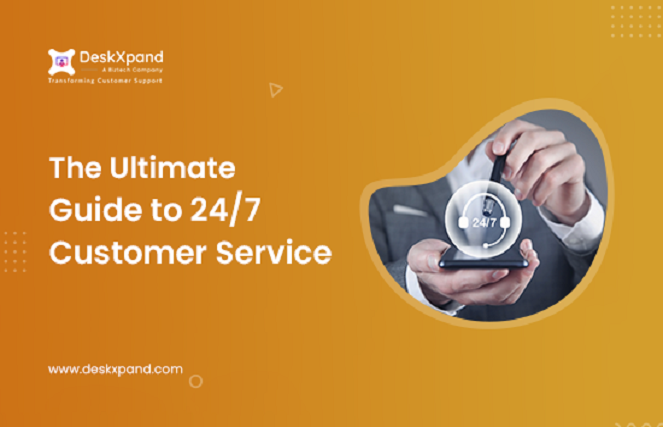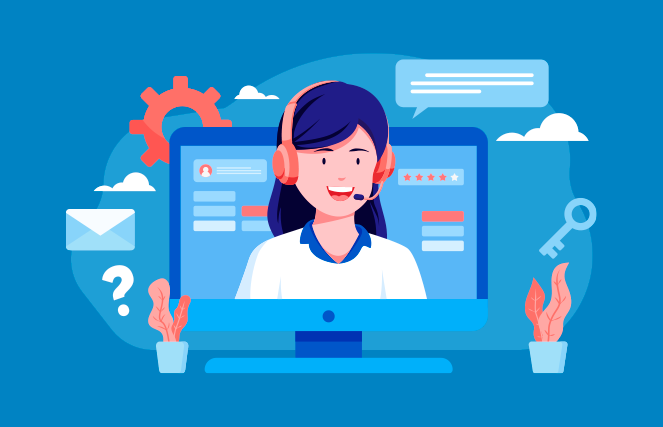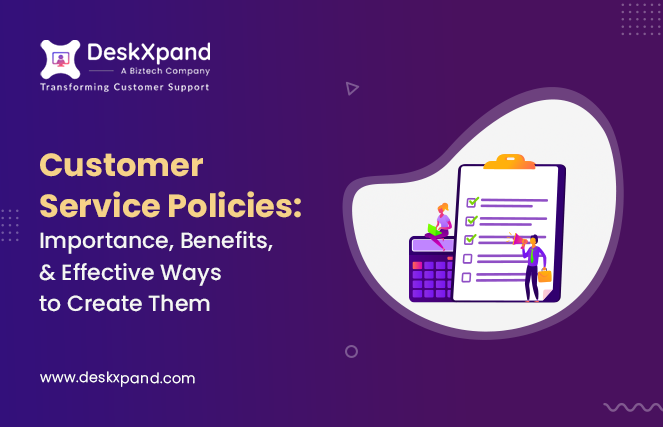Introduction
In today’s competitive business landscape, catering to the unique needs of enterprises is crucial for fostering long-term partnerships and driving success.
This guide will equip you with the knowledge and insights to optimize your customer service operations, enhance client satisfaction, and gain a competitive edge.
From personalized support to proactive engagement, we will shed some light on some proven tips that will elevate your enterprise customer service to new heights.
Join us on this journey to unlock the secrets of delivering outstanding support, nurturing strong relationships, and becoming a trusted partner.
Let’s start from the basics by first understanding what enterprise customer service is:
What Is Enterprise Customer Service
Enterprise customer service refers to the support and assistance provided to customers within the context of a large-scale business or organization. It focuses on addressing customers’ needs and concerns to improve their experience. Enterprise customer service goes beyond traditional customer support by providing comprehensive assistance throughout the customer’s journey, from pre-sales inquiries to post-sales support. It involves managing and resolving complex issues that arise in a business-to-business (B2B) environment. The main goal is to ensure customer satisfaction, build long-term relationships, and foster loyalty among enterprise clients.
Benefits of Effective Customer Service for Enterprises
1. Increased Customer Loyalty and Retention
When businesses prioritize delivering exceptional support to their customers, it creates a positive and satisfying experience that builds loyalty. By promptly addressing customer inquiries, concerns, and issues, enterprises demonstrate their commitment to customer satisfaction, building trust and confidence. This level of personalized attention and care makes customers feel valued and appreciated, leading to stronger emotional connections and a higher likelihood of repeat business.
Moreover, satisfied customers are more likely to become advocates for the enterprise, spreading positive word-of-mouth recommendations and attracting new clients. By consistently delivering outstanding customer service, enterprises can reduce customer churn and create a loyal customer base that becomes a sustainable source of revenue and growth.
2. Competitive Advantage
By providing personalized and proactive assistance, resolving issues promptly, and exceeding customer expectations, enterprises can differentiate themselves from their competitors based on the quality of their customer service. Satisfied customers are more likely to choose the enterprise over competitors, even if they offer similar products or services. Exceptional customer service can also attract new customers and expand the enterprise’s reach.
Additionally, by closely engaging with customers, enterprises gain valuable insights into their needs, preferences, and pain points. This enables them to continuously improve their offerings, enhance the customer experience, and stay ahead of the competition. Ultimately, effective customer service gives enterprises a competitive edge by building customer loyalty, attracting new business, and driving long-term success.
3. Enhanced Customer Insights
Effective customer service not only helps enterprises build strong relationships with their customers but also provides valuable opportunities to gain enhanced customer insights. By engaging with customers directly and actively listening to their needs, concerns, and feedback, enterprises can gather valuable information about their preferences, pain points, and expectations.
Through interactions with customer service agents, enterprises can uncover patterns, trends, and emerging needs in the market. This knowledge enables enterprises to make informed business decisions, refine their products or services, and develop targeted marketing strategies. Ultimately, effective customer service acts as a gateway to enhanced customer insights, empowering enterprises to make strategic decisions that drive business growth and customer satisfaction.
4. Higher Customer Satisfaction
Enterprises can ensure that customer inquiries and concerns are addressed in a timely and satisfactory manner by offering effective customer service. This level of attentiveness and responsiveness demonstrates that the enterprise values its customers and their needs. Additionally, effective customer service can also help enterprises to create a positive and seamless customer experience.
When enterprises go above and beyond to exceed customer expectations, it generates a sense of delight and builds a strong emotional connection. Satisfied customers are more likely to become loyal to your business over time. By prioritizing effective customer service, enterprises can elevate customer satisfaction levels, build stronger relationships, and create a strong position for themselves in the market.
5. Reduced Customer Complaints
Effectively addressing customer concerns proves the enterprise’s commitment to resolving problems and satisfying its customers. Through effective communication, active listening, and empathetic problem-solving, enterprises can identify and resolve issues efficiently. Furthermore, effective customer service involves continuous improvement based on customer feedback.
By actively seeking feedback, analyzing trends in complaints, and taking proactive measures to address common pain points, enterprises can prevent recurring issues. A well-managed customer service process that consistently meets customer needs and exceeds their expectations significantly minimizes the likelihood of formal complaints.
6. Increased Revenue and Sales
When customers receive exceptional support, they are more likely to develop a positive perception of the enterprise and its offerings. Satisfied customers tend to make repeat purchases and potentially increase their spending over time. Moreover, word-of-mouth recommendations from satisfied customers can attract new clients and expand the customer base.
Additionally, effective customer service provides an opportunity to upsell or cross-sell relevant products or services. These efforts contribute to increased average order values and overall revenue. Furthermore, customer feedback obtained through customer service interactions can inform product or service improvements, enabling enterprises to better meet customer needs and drive sales growth.
Tips for Enterprises to Offer Great Service to Their Customers
1. Create a Customer-Centric Culture
Creating a customer-centric culture starts by instilling a shared belief and understanding that customer satisfaction and needs are at the core of every business. By prioritizing the customer’s perspective, enterprises can align their strategies, processes, and employee behaviors to deliver exceptional service. A customer-centric culture builds a mindset where employees actively listen to customers, empathize with their concerns, and strive to exceed their expectations.
It encourages collaboration across departments to ensure a seamless and consistent customer experience at every touchpoint. Furthermore, enterprises with a customer-centric culture empower their employees with the authority to make decisions that benefit customers. This flexibility and responsiveness enhance the speed and quality of issue resolution, leading to greater customer satisfaction.
2. Implement Multichannel Communication
With the increasing diversity of communication preferences among customers, providing omnichannel support for interaction allows enterprises to meet customers where they are most comfortable. Whether it’s phone calls, emails, live chat, social media, or self-service portals, a multichannel approach ensures that customers can engage with the enterprise through their preferred channel. This flexibility enhances convenience and accessibility.
By effectively managing these communication channels, enterprises can ensure consistent and personalized interactions and higher customer satisfaction. Moreover, multichannel communication allows for proactive engagement, such as sending timely updates, notifications, and personalized offers to customers. Hence, a well-integrated multichannel communication strategy can result in greater customer satisfaction and loyalty.
3. Personalize Customer Interactions
By understanding and catering to the individual needs, preferences, and history of each customer, enterprises can create a highly tailored and memorable experience. Personalization demonstrates that the enterprise values and appreciates each customer as a unique individual. It allows for customized recommendations, proactive problem-solving, and relevant offers that resonate with the customer’s specific interests.
For example, a clothing retailer that personalizes customer interactions may use purchase history to provide personalized product recommendations, exclusive discounts, etc. to attract customers’ eyeballs. This level of personalization not only enhances customer satisfaction but also creates a sense of loyalty and connection with the enterprise.
4. Empower Customer Service Teams
Empowering customer service teams is a crucial factor in enabling enterprises to offer great customer service. And enterprise help desk software can be the perfect solution to do so. When customer service agents are empowered with such software, they can provide efficient and effective customer support. Help desk software can help them to make decisions in real time, resolve issues promptly, and go above and beyond to meet customer needs.
By entrusting customer service teams with decision-making capabilities, enterprises can ensure quick problem resolution without the need for constant escalation. Help desk software can also help your agents in enhancing their productivity and effectiveness by streamlining the service process.
5. Proactively Engage with Customers
Instead of waiting for customers to reach out with inquiries or issues, proactive engagement involves anticipating customer needs, providing relevant information, and offering assistance before customers even realize they need it. This approach showcases the enterprise’s commitment to customer satisfaction and goes beyond reactive support.
For example, a software company may proactively engage customers by sending regular updates about new features, offering tutorials or training resources, and reaching out to provide personalized recommendations based on the customer’s usage patterns.
By taking the initiative to reach out and provide value-added support, enterprises not only enhance the customer experience but also strengthen their relationship with customers. Proactive engagement demonstrates attentiveness, thoughtfulness, and a deep understanding of the customer’s needs, ultimately leading to increased customer satisfaction.
6. Streamline Complaint Resolution Processes
When customers have complaints or issues, a quick and efficient resolution process can turn a negative experience into a positive one. By implementing streamlined processes, enterprises can ensure that customer complaints are addressed quickly, reducing frustration and minimizing the negative impact on customer satisfaction. This involves having clear and well-defined complaint escalation channels and empowered customer service agents who can handle complaints effectively.
Additionally, enterprises can leverage technology, such as help desk software, to track and manage complaints efficiently. By streamlining complaint resolution processes, enterprises demonstrate their commitment to resolving issues and prioritizing customer satisfaction, thereby enhancing their reputation and building trust with customers.
7. Collect and Act on Customer Feedback
By actively seeking feedback from customers, enterprises gain valuable insights into their experiences, expectations, and areas for improvement. Feedback serves as a compass for understanding customer needs and identifying pain points in the customer journey. By analyzing and acting upon this feedback, enterprises can make informed decisions to enhance their products, services, and customer support processes.
For example, an e-commerce platform may collect feedback from customers regarding their website usability and navigation. Based on this feedback, they can make user interface improvements, simplify the checkout process, or introduce new features that align with customer preferences. By demonstrating a commitment to listening and responding to customer feedback, enterprises can build trust and continuously improve their customer service to meet evolving customer expectations.
8. Leverage Automation for Enhanced Results
By incorporating technology-driven automation solutions into their customer service processes, enterprises can streamline operations, improve efficiency, and deliver faster and more accurate support. Automation can handle routine tasks such as ticket management, basic inquiries, and data entry, freeing up human resources to focus on more complex customer needs. This not only reduces response times but also ensures consistency in service delivery.
For example, an airline company may implement an automated system that provides customers with real-time flight updates, boarding gate information, and baggage tracking, reducing the need for customers to contact support agents for basic inquiries. By leveraging automation, enterprises can enhance their service quality, reduce human errors, and provide round-the-clock support.
How an Enterprise Help Desk Software Can Level Up Customer Service
1. Boosts Efficiency And Productivity of the Agents
An enterprise help desk software centralizes and streamlines the support process, it provides a cohesive platform for agents to manage and resolve customer issues effectively. With features like ticket management, automated routing, and prioritization, agents can handle a higher volume of inquiries while ensuring timely responses and resolutions. The software also facilitates collaboration among agents, allowing them to share information, knowledge, and best practices.
By leveraging a knowledge base and predefined responses, agents can provide consistent and accurate solutions, reducing response time and improving customer satisfaction. Additionally, analytics and reporting capabilities enable managers to track agent performance, identify bottlenecks, and implement targeted training programs, further boosting efficiency and productivity. Overall, enterprise help desk software empowers agents with the tools and resources to help them boost their efficiency and productivity.
2. Empowers Customers with the Luxury of Self-service
An enterprise help desk software empowers customers by offering them the luxury of self-service. With the software’s intuitive and user-friendly interface, customers can access a knowledge base or a self-service portal to find answers to common questions and troubleshoot issues on their own. This eliminates the need for customers to wait for agent assistance, leading to faster resolution times and enhanced satisfaction. To help customers solve their own issues, self-service includes options such as FAQs, tutorials, step-by-step guides, etc., that equip customers with the information they need to resolve problems independently.
By encouraging self-service, the software promotes a sense of empowerment and self-reliance among customers, enabling them to take control of their support experience. This not only saves time and effort for customers but also reduces the workload for support agents, allowing them to focus on more complex and specialized issues. Overall, enterprise help desk software empowers customers with self-service options, improving their satisfaction and overall support experience.
3. Seamless Collaboration Amongst Agents
An Enterprise Help Desk Software helps the service team to effectively communicate and share their knowledge. Agents can easily collaborate on support tickets, share insights, and discuss resolutions in real time. The software often includes features such as internal notes, merging tickets, creating parent-child tickets, etc., which enable agents to communicate and collaborate within the context of specific customer inquiries.
This streamlines the collaboration process and ensures that agents have access to all relevant information when working on customer issues. Furthermore, the software may offer shared inboxes allowing agents to distribute and delegate tasks efficiently. This creates a sense of teamwork and enables agents to work together seamlessly, even when handling high volumes of inquiries.
4. Helps Service Department to Take Data-driven Decisions
An enterprise help desk software captures and stores a wealth of information about customer inquiries, ticket volumes, response times, and agent performance. By leveraging the analytics and reporting capabilities of the software, service teams can access valuable insights and metrics that help them understand the overall performance of the support team. They can also identify trends, patterns, and areas of improvement, based on which they can make informed decisions to optimize processes and enhance customer service.
For example, they can identify common issues that generate a significant number of support tickets and take proactive measures to address those issues at their root cause. They can also monitor agent performance metrics to identify training needs or allocate resources more effectively. These metrics can help them to make data-driven decisions that drive continuous improvement and streamline service department operations.
5. Offers Automation to Boost Performance
An enterprise help desk software streamlines repetitive and manual tasks, allowing agents to focus on more complex and value-added activities. Through automation, tickets can be automatically assigned, categorized, and prioritized based on predefined rules and parameters. This ensures that customer inquiries are routed to the most appropriate agent or team, improving efficiency and reducing response times.
Furthermore, the software can automate notifications and escalations, ensuring that tickets are addressed within specified service level agreements (SLAs). By automating routine processes, the software eliminates human error, increases consistency, and enhances overall productivity. Overall, an enterprise help desk software leverages automation to optimize performance, improve productivity, and deliver faster and more efficient customer support.
6. Builds Great Customer Experience with Personalization
An enterprise help desk software allows agents to access comprehensive customer profiles, including past interactions, preferences, and history. With this information at hand, agents can provide a personalized and tailored support experience to each customer. They can address customers by name, refer to previous interactions, and demonstrate a deep understanding of their unique needs.
The software also enables agents to capture and store customer preferences, such as preferred communication channels or language preferences. By leveraging this data, agents can ensure that customers are contacted through their preferred channels, enhancing convenience and satisfaction.
Factors to Consider Before Selecting an Appropriate Enterprise Help Desk Software
1. Features and Functionality
By carefully examining the features, businesses can ensure that the software aligns with their specific needs and requirements. Understanding the functionalities offered by the software allows organizations to assess whether it can streamline their support processes effectively and address their unique challenges.
By checking the features and functionality, businesses can determine if the software offers key capabilities such as ticket management, automation, reporting, knowledge base, collaboration tools, and integration options. Overall, thoroughly examining the features and functionality of an enterprise help desk software is crucial to selecting a solution that will best suit the organization’s support goals.
2. No. of Agents that can Access the Software Simultaneously
The ability for multiple agents to access the software simultaneously directly impacts the efficiency and responsiveness of the support team. A software that allows sufficient access ensures that agents can collaborate in real-time, share information, and work on customer inquiries simultaneously, thereby reducing response times.
By checking the simultaneous access capacity, organizations can ensure that the software can accommodate their current team size and future growth plans. This ensures that all agents have equal and uninterrupted access to the system, optimizing their productivity and ultimately enhancing the overall customer support experience.
3. User Interface and User Experience
The UI and UX determine how intuitive, user-friendly, and visually appealing the software is for agents and customers alike. A Well-designed and intuitive UI enables agents to navigate the software seamlessly, access key functionalities quickly, and efficiently manage customer inquiries. It reduces the learning curve and enhances productivity by ensuring agents can easily find the information and tools they need to deliver exceptional support.
Additionally, a positive UX enhances overall satisfaction, as agents can accomplish tasks with ease and enjoy a smooth workflow. A visually appealing and intuitive interface also creates a positive impression and reinforces the professionalism of the organization. Therefore, evaluating the UI and UX of an enterprise help desk software is crucial before selecting an enterprise help desk software.
4. Integration Capabilities
Integration plays a vital role in streamlining workflows and maximizing the effectiveness of the software. By evaluating the integration capabilities, organizations can ensure that the help desk software seamlessly integrates with other essential tools and systems already in use, such as CRM platforms, communication channels, or project management software.
This enables agents to access relevant customer data, communication history, and other important information from a single interface, enhancing efficiency and productivity. Integration also facilitates the automatic synchronization of data, reducing manual data entry and minimizing the risk of errors. Additionally, integration allows for a unified view of customer interactions across different touchpoints, providing a proper understanding of the customer journey.
5. Reporting and Analytics
Reporting and analytics provide valuable insights into the performance and effectiveness of the support team, enabling organizations to make data-driven decisions. By evaluating the reporting capabilities, businesses can assess whether the software provides comprehensive and customizable reports on key metrics such as ticket volumes, response times, resolution rates, and customer satisfaction.
These reports help managers monitor team performance, identify bottlenecks, and allocate resources effectively. Analytics functionality allows for deeper analysis, uncovering trends, patterns, and areas for improvement. By examining the analytics capabilities, organizations can determine if the software offers advanced features to help them offer proactive support.
6. Security and Data Privacy
Customer data is highly sensitive, and organizations have a responsibility to protect it from unauthorized access and breaches. By evaluating the security measures of the software, businesses can ensure that it meets industry-standard security protocols, such as encryption, access controls, and vulnerability assessments. Robust security measures safeguard customer information and protect against data breaches.
Additionally, it is crucial to examine the software’s data privacy policies and compliance with relevant regulations. This ensures that customer data is handled in a responsible and compliant manner, with consent and appropriate data retention practices. Checking the security and data privacy aspects of the help desk software provides peace of mind, knowing that customer data is secure.
7. Cost and ROI of the Software
Assessing the cost allows businesses to evaluate the financial and long-term sustainability of the software. It is important to consider factors such as licensing fees, implementation costs, ongoing maintenance charges, and any additional costs associated with integrations or customization. By thoroughly understanding the costs involved, organizations can make informed decisions that align with their budget.
Additionally, evaluating the ROI potential helps businesses assess the value and benefits they can derive from the software. This includes considering factors such as increased efficiency, improved productivity, reduced support costs, and enhanced customer satisfaction. A thorough cost and ROI analysis enables organizations to choose a help desk software that not only fits their budget but also delivers substantial returns.
Conclusion
This exclusive guide to enterprise customer service provides valuable insights into the benefits and tips for optimizing customer support. By implementing an enterprise help desk software, organizations can enhance efficiency, productivity, and collaboration among agents. The software empowers customers with self-service options, enabling them to find answers and resolve issues independently. Furthermore, the software helps to analyze metrics, boosts performance, enhance customer experiences through personalization, etc. By following the guide’s tips and harnessing the power of an enterprise help desk software, organizations can elevate their customer service and drive success in the competitive business landscape.







